Highly-visible signage is an essential life safety measure
Most people can figure out how to exit a building in normal circumstances. But add fear and an emergency, and normal tasks suddenly become difficult. Darkness after losing power and a fire’s smoke make everything worse. This is why it’s so essential to make egress—the act of escaping a building—simple and easy. And glow in the dark exit signs that are approved by OSHA are one way of lighting the way to safety.
In this article, we look at the requirements from OSHA, NFPA, and the IBC for the listing and performance of photoluminescent signs. These mandates include the need for proper light sources, glow duration, and legibility from a distance.
Feel free to skip to the sections on:
- The basics of photoluminescent exit signs and egress markers
- Listing requirements from IBC, NFPA 101, and others for photoluminescent signs
- Are photoluminescent signs OSHA-compliant?
- Installing, inspecting, and testing photoluminescent safety signs
The basics of photoluminescent exit signs and egress markers
Effective means of egress are described and regulated by multiple model building and safety codes. The National Fire Protection Association’s NFPA 101: Life Safety Code (2018 edition) is one key document. Another is the International Building Code (IBC, 2018 edition), which has been incorporated into the building codes of every U.S. state.
Proper signage is a key part of emergency preparedness, which is why you see light-up “EXIT” signs everywhere. Smaller egress markers, which often have arrows indicating direction and pictographs of a running man, are also common. These give directions in confusing parts of a building or where exit signs are far apart. All signs have to work well in the dark and without main power, so NFPA 101 and IBC both have specific requirements for backup illumination.
Photoluminescent signs (aka “glow-in-the-dark signs”) are a useful technology for exit and egress signage. They glow without a dedicated power source. Instead, they absorb the energy of light from normally well-lit surroundings—often a particular wavelength of light—and release it over time as a glow. The brightness of their glow diminishes after the charging light source is removed, but glow in the dark signs that are NFPA-, IBC-, and OSHA-compliant remain visible long enough to get people to safety.
Photoluminescent signs can be used as egress markers and exit signs as long as they meet the necessary performance standards. Indeed, many egress markers (being smaller and more common than exit signs) must be self-luminescent—electric illumination won’t do.
Listing requirements from IBC, NFPA 101, and others for photoluminescent signs
Neither NFPA 101 nor IBC go into great detail when describing the requirements for photoluminescent signs. They instead defer to listing and testing authorities, namely UL (formerly Underwriters Laboratory) and ASTM International (ASTM). Local laws may have their own requirements, however. For example, New York City’s building laws reference the city’s Reference Standards (RS), which are also used to test and evaluate signs. NFPA 101, IBC, UL, and local evaluators all distinguish between exit signs and egress markers in their standards and requirements.
Listing and characteristics of photoluminescent egress markers
Egress markers are a broad class of markers that indicate the escape path. These markings are required by jurisdictions such as New York City in certain tall buildings (read more about this in our article on code requirements for photoluminescent egress and exit signs). NFPA 101 also requires them in different kinds of occupancies, whose needs are discussed in chapters 11 through 43.
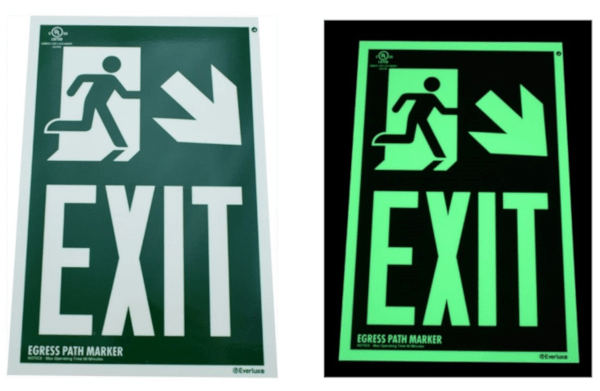
Egress markers have to be seen in the dark. Unless you opt for radioluminescent tritium signs—an alternative that uses radioactive gas—egress markers must be photoluminescent. NFPA 101’s section 7.10.1.7 says that these signs, where required, must be internally luminescent. This leaves room for electric bulbs, tritium luminescence, or photoluminescence. But the IBC does not allow electrically powered egress path markers, saying:
1024.4 Self-luminous and photoluminescent.
Luminous egress path markings shall be permitted to be made of any material, including paint, provided that an electrical charge is not required to maintain the required luminance. Such materials shall include, but are not limited to, self-luminous materials and photoluminescent materials. […]
Under NFPA 101, “floor proximity egress path markers” have to be listed by UL 1994: Standard for Luminous Egress Path Marking Systems.
From the 2018 edition of NFPA 101
7.10.1.7* Floor Proximity Egress Path Marking. […]
Where floor proximity egress path marking is required in Chapters 11 through 43, an approved floor proximity egress path marking system that is internally illuminated shall be installed within 18 in. (455 mm) of the floor. Floor proximity egress path marking systems shall be listed in accordance with ANSI/UL 1994, Standard for Luminous Egress Path Marking Systems. […]
IBC also names UL 1994 as the listing authority for egress markers, though it also allows for ASTM compliance as an alternative when certain extra provisions are met.
From the 2018 edition of the International Building Code
1025.4 Self-luminous and photoluminescent.
[…] Materials shall comply with either of the following standards:
- UL 1994.
- ASTM E 2072, except that the charging source shall be 1 footcandle (11 lux) of fluorescent illumination for 60 minutes, and the minimum luminance shall be 30 millicandelas per square meter [mcd/m2] at 10 minutes and 5 millicandelas per square meter after 90 minutes.
Listing and characteristics of exit signs
Exit signs, which mark doors used to exit a building as well as intervening doors on the route to exits, are subject to stronger visibility and illumination standards under IBC and NFPA 101. Exit signs have these high standards because they are the signs that specifically say, “Go through this door to get to safety.”
Both the IBC and NFPA 101 require exit signs to be listed under UL 924: Standard for Emergency Lighting and Power Equipment. Exit signs do not have to be photoluminescent, but they can be, as long as they meet the requirements, carry the proper UL 924 listing, and are installed to function as intended.
From the 2018 edition of the International Building Code
1013.5 Internally illuminated exit signs.
Electrically powered, self-luminous and photoluminescent exit signs shall be listed and labeled in accordance with UL 924 and shall be installed in accordance with the manufacturer’s instructions and Chapter 27. Exit signs shall be illuminated at all times.
This echoes previous requirements for constant illumination. As we shall see, this is a common theme with photoluminescent signs—they must constantly receive illumination under non-emergency circumstances and be able to provide illumination for a long time in the dark.
NFPA 101 names UL 924 as the listing standard for exit signs in section 7.10.7.1, unless they have “legible letters not less than 4 inches” high, they are approved by the authority having jurisdiction (AHJ), and they meet other requirements in sections 7.10.1.3 and 7.10.1.6. But it’s a lot easier to choose a UL 924-listed sign.
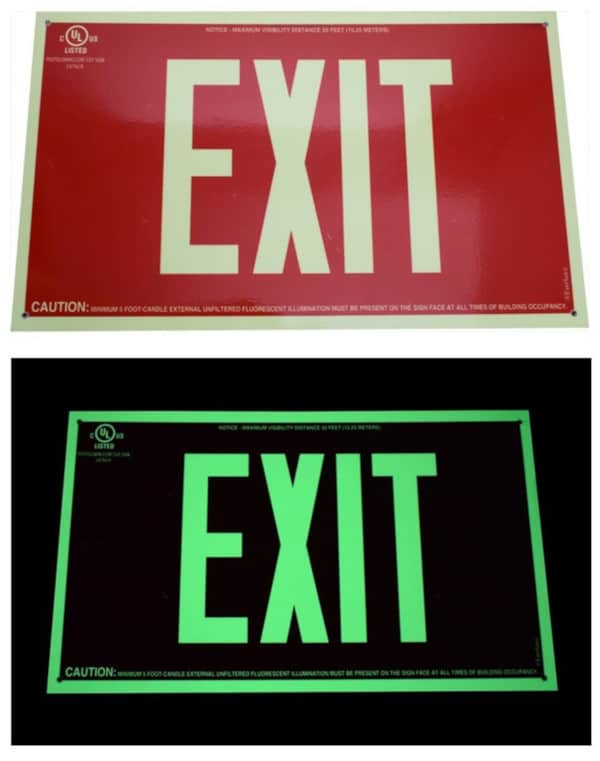
Photoluminescent signs must charge under proper lighting
Photoluminescent pigment absorbs energy from specific wavelengths of light and emits that energy over time as it glows. This is what makes photoluminescent materials attractive for safety lighting—electricity may fail in emergencies like fires and earthquakes. Glow-in-the-dark signage doesn’t require backup power like electrically illuminated signage.
However, you can’t leave it to chance that photoluminescent egress and exit signs will be able to glow when the power goes out. They have to “charge” in appropriate levels of lighting. NFPA 101 specifies the following:
7.10.7.2* Photoluminescent Signs. The face of a photoluminescent sign shall be continually illuminated while the building is occupied. The illumination levels on the face of the photoluminescent sign shall be in accordance with its listing. The charging illumination shall be a reliable light source, as determined by the authority having jurisdiction. The charging light source shall be of a type specified in the product markings.
The listing authority will specify how much and what kind of light a photoluminescent sign needs to receive for a certain period to reach a full charge.
For instance, the manufacturer’s datasheet for the Everlux Photoluminescent Egress Path Marker specifies that the sign needs to charge for 60 minutes in 1 footcandle (11 lux) illumination from a fluorescent bulb to function properly. Other data sheets give RS and UL performance data.
The IBC goes beyond NFPA 101 in its requirements for egress sign charging times. Section 1025.5 states that photoluminescent exit path markings must be continuously illuminated with at least 1 foot-candle (11 lux) of lighting while the building is occupied, and for 60 minutes before it is occupied.
Exit signs have to charge under more intense illumination than do egress markers. Under UL 924 requirements, photoluminescent exit signs require 5 foot-candles of illumination to charge properly.
Having proper charging lighting is one of the core factors you have to consider before using photoluminescent markers of any kind. If the surrounding lights are turned off at any time during occupied hours—say, because they are on a timer—photoluminescent signs are not permitted.
Moreover, if you don’t have the right kind of bulb, photoluminescent signs are not permitted. Different bulbs, as NFPA 101 A.7.10.7.2 says, give off different types of lights, and these differences determine if the sign will charge. The required light source is specified by the manufacturer and the authority who lists the sign.
Photoluminescent signs have to keep working for 90 minutes
Beyond remaining fully charged in case of emergencies, glow-in-the-dark signs must produce enough light for enough time in darkness. After all, the whole point of photoluminescent exit signs and egress markers is to show a safe escape path if the power is out.
UL 924 (which gives the requirements for UL-listed exit signs) says that exit-sign illumination must persist at minimum levels at least 90 minutes after power is lost. This 90-minute illumination requirement also applies to egress markers according to the IBC (1025.4).
But how brightly do photoluminescent signs and markers need to glow? Glow-in-the-dark exit signs need to remain legible from 100 feet away in complete darkness. IBC 1013.1 requires exit signs to be placed within 100 feet of any point in the area or within their listed viewing distance from the next closest sign. UL 924 lists nonelectric exit signs for viewing distances of 50, 75, 100, or 125 ft. What this means: If a sign has a listed viewing distance of, say 50 feet, you need to have photoluminescent signs guiding the way every 50 feet until the exit is visible.
Signs also need to have a surface luminance of at least 0.06 foot-lamberts (0.21 cd/m2) to meet UL 924 requirements.
What about OSHA? Are Photoluminescent Signs OSHA-Compliant?
NFPA 101 and IBC are both clear on their requirements for photoluminescent signs. But what about the Occupational Safety and Health Administration (OSHA)? When an inspector comes knocking, will they be okay with photoluminescent exit and egress signs? The answer is yes—if the signs meet certain basic requirements.
OSHA and photoluminescent exit signs
OSHA’s requirements for exit signs include the following:
From 1910.37 – Maintenance, safeguards, and operational features for exit routes
1910.37(b)(6) Each exit sign must be illuminated to a surface value of at least five foot-candles (54 lux) by a reliable light source and be distinctive in color. Self-luminous or electroluminescent signs that have a minimum luminance surface value of at least .06 footlamberts (0.21 cd/m2) are permitted.
1910.37(b)(7) Each exit sign must have the word “Exit” in plainly legible letters not less than six inches (15.2 cm) high, with the principal strokes of the letters in the word “Exit” not less than three-fourths of an inch (1.9 cm) wide.
OSHA requires 5 foot-candles of surface illumination. This is consistent with the requirements for a UL 924 listing. The required luminance levels for self-luminous exit signs of 0.06 footlamberts is also the same as the UL 924 requirement.
OSHA and photoluminescent egress markers
OSHA makes little comment on the illumination of egress markers, saying:
From 1926.34 Means of Egress
1926.34(b)
“Exit marking.” Exits shall be marked by a readily visible sign. Access to exits shall be marked by readily visible signs in all cases where the exit or way to reach it is not immediately visible to the occupants.
OSHA’s requirements for signs that clarify the way to the exit echo the basic definition of egress markers, and only say they must be “readily visible.” Follow NFPA and IBC requirements to make sure you have the right signs.
Installing, inspecting, and testing photoluminescent safety signs
Proper installation of photoluminescent signs
You can’t just hang a sign however you like; there are rules for this stuff. When you install a photoluminescent sign, follow these general steps:
- Be sure that the sign, when installed, will receive the light levels its listing requires. A light meter can be useful.
- Check that, when installed, the sign will be visible and legible from its listed viewing distance in the dark.
- Ensure that the controls for a sign’s charging light source are not publicly accessible. The light source must also not be controlled by motion detectors or timers.
- Firmly attach the sign to the mounting surface according to manufacturer instructions and code requirements.
If you wanted to install an Everlux White-on-Red Photoluminescent EXIT sign, for instance, you would need information from the manufacturer’s datasheet. This sign requires 5 foot-candles (54 lux) from a fluorescent light source and has a maximum viewing distance of 50 feet.
To install it, ensure that it receives the proper illumination, verify that no switches controlling the illumination are accessible, on timers, or connected to motion detectors, and check its legibility at max viewing distance.
Inspection and testing of photoluminescent exit signs
Section 7.10.9 of NFPA 101 specifies that all exit signs need to be inspected for proper function every month. Moreover, electrical signs with batteries need to be tested for 90 minutes of function during a power outage every year.
Photoluminescent exit signs don’t require yearly testing because they don’t have batteries. However, they do need a monthly inspection:
From the 2018 edition of NFPA 101
7.10.9.1 Inspection. Exit signs shall be visually inspected for operation of the illumination sources at intervals not to exceed 30 days or shall be periodically monitored in accordance with 7.9.3.1.3.
No specific guidance is offered on what that should involve. However, you should ensure that your signs remain clean and unobstructed and that your charging light source still illuminates to the proper levels. For photoluminescent signs, having a charging light bulb go out isn’t just a nuisance, it’s a code violation.
Also, do a brief 30-second check that the sign itself illuminates properly and that its glow-in-the-dark functionality is intact. This check somewhat mirrors the requirements for battery-powered emergency lighting in section 7.9.3.1 of NFPA 101. Keep good records of your inspections.
Photoluminescent signs, when properly listed and installed, make great exit signs and egress markers
Exit signs and egress markers must help people get to safety in an emergency—and they must remain visible and illuminated in the darkness caused by power failure. Photoluminescent signs are a great way to get this done.
Glow-in-the-dark exit signs can be used in place of electric signs and may be the only viable option for more frequently used egress markers. OSHA, the IBC, and NFPA 101 all permit photoluminescent signs. However, glow-in-the-dark signs have to be properly listed for the purpose.
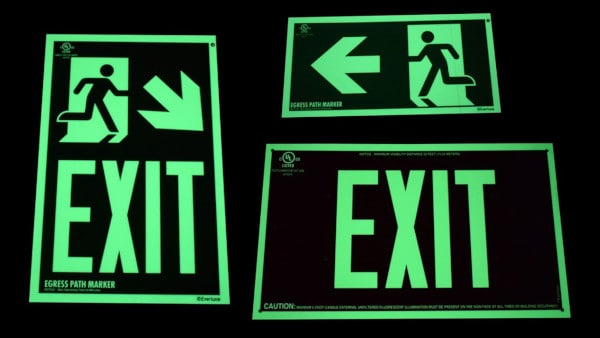
Navigating all the requirements for glow-in-the-dark egress markers and exit signs—from IBC, NFPA, UL, OSHA, and local jurisdictions—is complex. But Everlux makes it easy.
All of their exit signs carry the proper UL listings and meet the standards of OSHA, NFPA 101, IBC, and more. Everlux signs and markers charge fast, glow brightly, and keep their glow for 90 minutes.
Everlux exit signs are easy to install and customize. They come with hardware for direct wall mounting, and the frame components for flag-mounting from a wall or ceiling are available. Also, each exit sign comes with adhesive photoluminescent chevrons (listed under UL 969) that can be applied to indicate the direction of the exit. Installing egress markers is also easy with heavy-duty double-sided tape.
QRFS is proud to carry a wide selection of UL-listed Everlux photoluminescent signs, including exit signs, egress markers, and markings for emergency equipment. To find signs and marks that meet your needs, check out the shopping list below, or browse our catalog.
Reach out to us at 1 (888) 361-6662 or support@qrfs.com with questions.
Shop IBC and NYC-Compliant Photoluminescent Safety Signs
12″ x 6″ Door Marker
|
|
12″ x 6″ Directional Marker with Arrow & Symbol |
|
8″ x 12″ Stairwell Marker with Arrow & Symbol |
|
This blog was originally posted at blog.qrfs.com. If this article helped you, check us out at Facebook.com/QuickResponseFireSupply or on Twitter @QuickResponseFS.


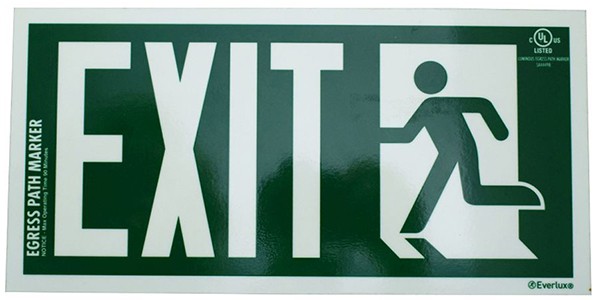
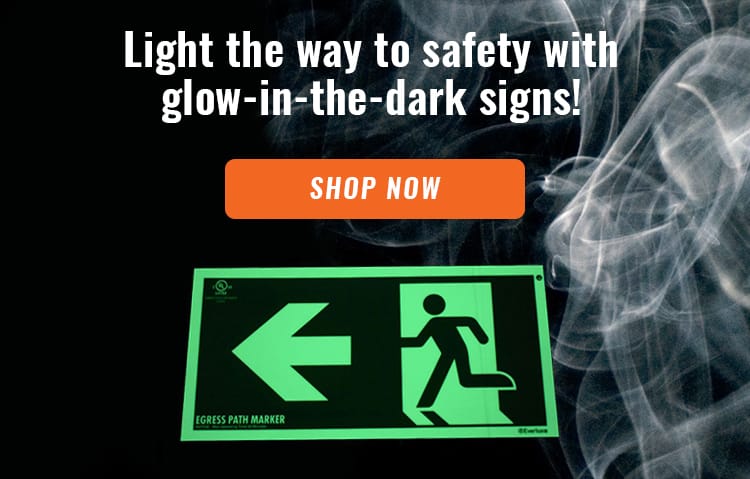
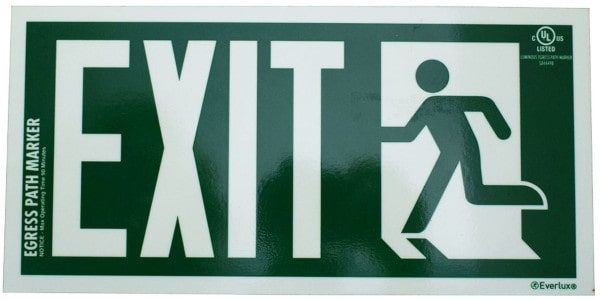
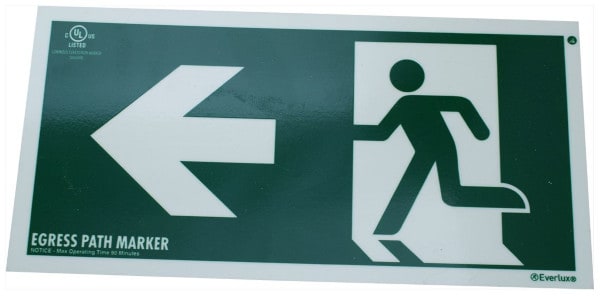
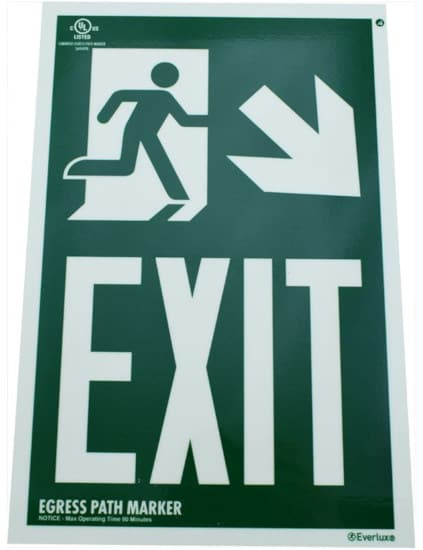
I did not know that installing an exit sign had to have standards to be able to be placed. My friend is creating a project to open a restaurant and he wants to make sure that he writes all the signage needed. I will recommend him to look for visible exit signs.